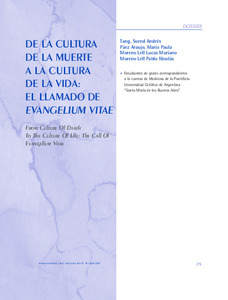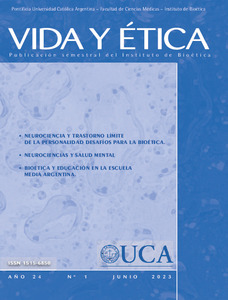Por favor, use este identificador para citar o enlazar este ítem:
https://repositorio.uca.edu.ar/handle/123456789/17061| Título: | De la cultura de la muerte a la cultura de la vida: el llamado de Evangelium vitae From culture of death to the culture of life: the call of Evangelium vitae |
Autor: | Tang Svend, Andrés Páez Araujo, María Paula Moreno Lell, Lucas Mariano Moreno Lell, Pablo Nicolás |
Palabras clave: | EVANGELIO; DIGNIDAD; VIDA; MUERTE; ENCICLICAS | Fecha de publicación: | 2023 | Editorial: | Educa | Cita: | Tang Svend, A. et al. De la cultura de la muerte a la cultura de la vida: el llamado de Evangelium vitae [en línea]. Vida y Etica. 2023, 24 (1). Disponible en: https://repositorio.uca.edu.ar/handle/123456789/17061 | Resumen: | Resumen: La encíclica Evangelium Vitae, escrita
por el papa Juan Pablo II el 25 de marzo
de 1995, es el núcleo del documento en
cuestión, en donde se analiza con profundidad la contestación de la Iglesia
Católica ante una lista de sucesos en el
siglo XX relacionados con la vida humana y su dignidad.
Dividido en cuatro partes principales:
la introducción que presenta el contexto histórico y social de la encíclica;
la resolución de los cuatro capítulos
postulados en Evangelium Vitae, abordando sus temas principales (aborto,
eutanasia, dignidad de la vida humana,
etc.), basándose en la idea de defender
la vida humana y buscándola proteger
en las etapas más vulnerables, ergo, los
extremos de la vida; el núcleo de interpretación, donde se analiza la postura
de la Iglesia Católica ante los actos de
la sociedad; y finalmente la descripción
de un caso clínico hipotético que sirve para ilustrar los temas presentados
anteriormente de forma breve. En conclusión, la encíclica Evangelium Vitae
sigue siendo un pilar en la actualidad
en el debate relacionado con la vida y
la dignidad humana. Abstract: The encyclical Evangelium Vitae, written by Pope John Paul II on March 25, 1995, is the core of the document in question, where the Catholic Church’s response to a list of events in the 20th century related to human life and dignity is analyzed in depth. Divided into four main parts: the introduction that presents the historical and social context of the encyclical; the resolution of the four chapters postulated in Evangelium Vitae, addressing its main themes (abortion, euthanasia, dignity of human life, etc.), based on the idea of defending human life and seeking to protect it in the most vulnerable stages, therefore, the extremes of life; the core of interpretation, where the position of the Catholic Church towards society’s actions is analyzed; and finally, the description of a hypothetical clinical case that serves to briefly illustrate the themes presented earlier. In conclusion, the encyclical Evangelium Vitae remains a cornerstone in the current debate related to life and human dignity. |
URI: | https://repositorio.uca.edu.ar/handle/123456789/17061 | ISSN: | 1515-6850 (impreso) 2683-6998 (online) |
Disciplina: | TEOLOGIA | Derechos: | Acceso abierto | Fuente: | Vida y Etica Año 24, No.1, 2023 |
| Aparece en las colecciones: | VE - 2023 Año 24 nro. 1 |
Ficheros en este ítem:
| Fichero | Descripción | Tamaño | Formato | |
|---|---|---|---|---|
| cultura-muerte-cultura-vida.pdf | 587,1 kB | Adobe PDF |  Visualizar/Abrir | |
| vidayetica2023-1-portada.pdf | 168,33 kB | Adobe PDF |  Visualizar/Abrir |
Visualizaciones de página(s)
103
comprobado en 27-abr-2024
Descarga(s)
322
comprobado en 27-abr-2024
Google ScholarTM
Ver en Google Scholar
Este ítem está sujeto a una Licencia Creative Commons

